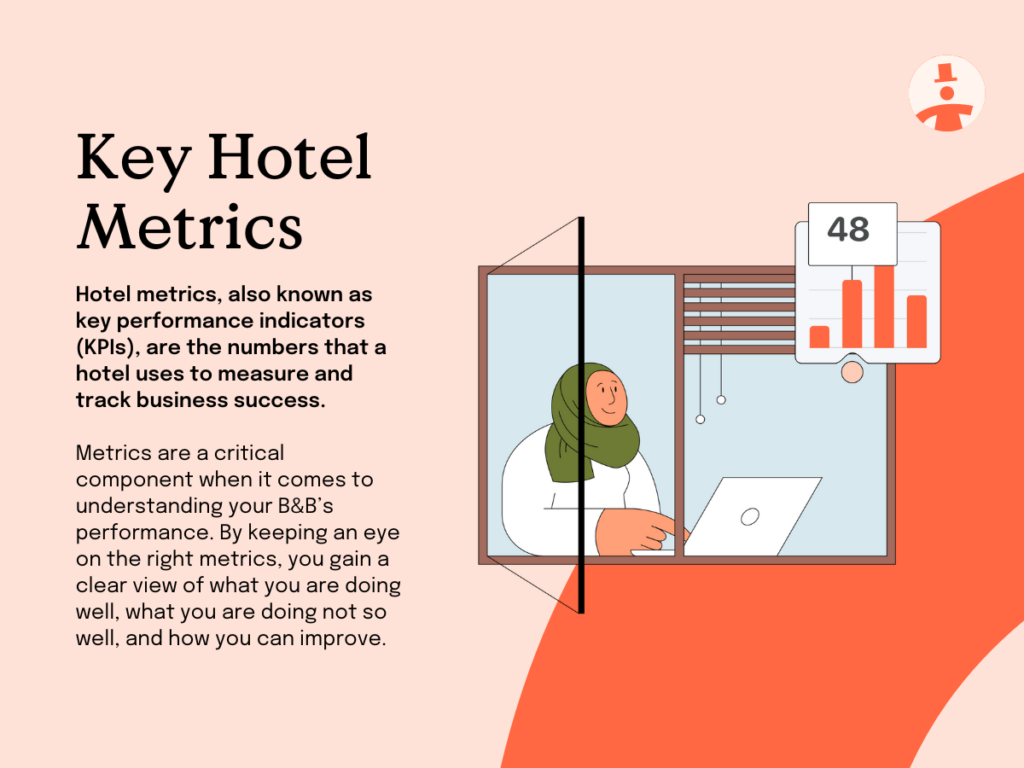What are hotel metrics?
Hotel metrics, also known as key performance indicators (KPIs), are the numbers that a hotel uses to measure and track business success.
Metrics are a critical component when it comes to understanding your B&B’s performance. By keeping an eye on the right metrics, you gain a clear view of what you are doing well, what you are doing not so well, and how you can improve.
Metrics can be used to track your success and to understand which types of marketing strategies work best for your property. They can be used to measure the performance of individuals, teams and the business at large. And ultimately they tell you whether your hotel is moving in the direction you want it to – i.e. toward its goals.
Gain a crystal clear view of your performance
With Little Hotelier you can compare the current performance of your property against previous years and competitors, to identify issues and opportunities.
Learn moreWhy are hotel metrics important?
Managing revenue and maximising profit is one of the most important tasks for any small hotel or bed and breakfast operator.
By collecting data on a regular basis and frequently evaluating the results through accurate reporting methods, you will have a better understanding of how you can improve your revenue management strategy and increase your profits.
High-quality and accurate hotel performance metric reporting offers insight into the overall success of your business. When you run the right reports at your property on a regular basis, you will have a better understanding of the results of your revenue management strategy.
You also will be able to clearly see how and when you can begin to increase your profits.
There are many small hotel strategies that can be used to manage your revenue and increase your profits — all you have to do is figure out the right strategies for your specific property.
Hotel performance metrics vs hotel benchmarking metrics
Hotel performance metrics, or KPIs, are slightly different to hotel benchmarking metrics. Hotel performance metrics turn the focus inward, while hotel benchmarking metrics look beyond the four walls of your establishment.
Hotel performance metrics are the numbers that tell you how the performance of your hotel is changing over time. By logging KPIs like financial growth, guest retention, ADR and RevPAR, you give yourself a baseline upon which to improve.
Rather than compare your property to itself, hotel benchmarking metrics are used to compare your property to competitors. Many of the same metrics apply (where available), but rather than comparing the metrics to your historical numbers, you’ll compare them to the current numbers of your competitors.

Key hotel industry performance metrics to know
Which hotel industry metrics should you be focusing on to gain a good understanding of your performance? Let’s take a look at a few hotel industry standard metrics, and a few slightly more specialised KPIs, to get a sense of the most important numbers to track.
1. Average Daily Rate
The average daily rate, or ADR, is one of the most critical metrics as it measures the average price that a guest pays per room at your hotel.
It allows you to measure and compare the room revenue generated during a specific time frame versus the amount of room revenue paid for by guests and the volume of occupied rooms at the property.
It’s one of the most important metrics because it provides insight into the average amount that a guest is paying per room at your hotel.
2. Revenue per Available Room
This is one of the most reliable indexes to consider when it comes to utilising metrics. Known as RevPAR, it’s a simple formula that requires you to divide the total revenue generated by the number of rooms booked during that time period.
The RevPAR metric gives an instant glimpse into the general success of the hotel by highlighting the potential profits.
3. Market Penetration Index
This metric can be used to compare your success to other competing properties in the local market. The market penetration index, or MPI, will indicate your share of the bookings within the market.
It allows you to understand how many guests are selecting your hotel versus another, and can help you adjust your marketing strategy to capture a higher volume of your target market.
4. Average Occupancy Rate
This simple yet powerful metric allows you to understand your occupancy rates during specific time periods.
You might use the average occupancy rate metric to understand occupancy levels during peak periods, holidays and the slow travel season. It is calculated by dividing the number of paid rooms by the number of rooms available.
5. Revenue Generation Index
The revenue generation index, or RGI, is a metric that allows you to compare your property’s RevPAR with the RevPAR of your competition in the local market. It is calculated by dividing your hotel’s RevPAR by that of the total market RevPAR.
If the result is one or greater, you are generating a favourable portion of the market revenue. If it’s less than one, you will want to consider options to help capture a greater share of the total market revenue.
6. Gross Operating Profit per Available Room
This is a powerful metric, as it allows you to understand your hotel’s success across all levels. Known in the industry as the GOPPAR, it allows you to identify which areas of your hotel generate the most revenue — and does not limit you to your revenue generated per room.
This metric indicates the success of a property by showcasing the earning potential of the hotel.
7. Marketing Cost per Booking
The marketing cost per booking metric, or MCPB, gives you an idea of how much you are spending to generate bookings from individual distribution channels.
To calculate this metric, you must identify the distribution costs for that channel and subtract those costs from the booking amount that the guest pays. You will want to focus your efforts on the least expensive distribution channels to maximise profits.
While it’s hard to manage all metrics all the time, it’s important to focus on ones you can control and impact with new strategies, so you can maximise your revenue.
By Dean Elphick
Dean is the Senior Content Marketing Specialist of Little Hotelier, the all-in-one software solution purpose-built to make the lives of small accommodation providers easier. Dean has made writing and creating content his passion for the entirety of his professional life, which includes more than six years at Little Hotelier. Through content, Dean aims to provide education, inspiration, assistance, and, ultimately, value for small accommodation businesses looking to improve the way they run their operations (and live their life).
Table of contents
“We’ve seen a 10-15% revenue increase with Little Hotelier. We had great support and met expectations during training. It’s very easy to manage via mobile app.”
Manager, Kränzel 21






